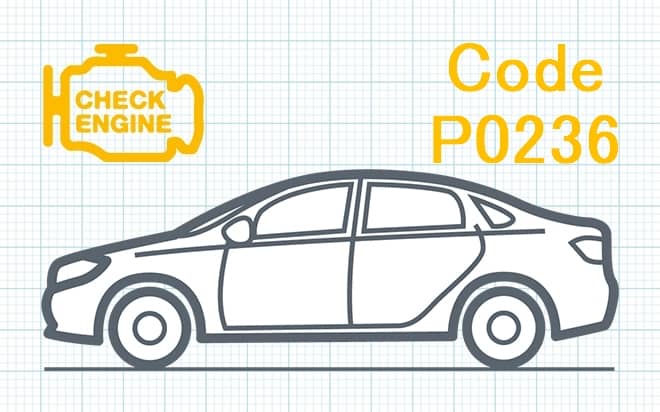
P0236 Turbocharger Boost Sensor A Range / Performance
Content
OBD-II Trouble Code - P0236 - Data Sheet
P0236: Turbocharger Boost Sensor GM Range/Performance: Turbocharger Boost System Performance Dodge Diesel Pickups: MAP sensor too high, too long.
What does trouble code P0236 mean?
This DTC is a generic transmission code that applies to all turbocharged vehicles. The differences in the above descriptions are related to the method of measuring the intake manifold pressure.
The powertrain control module (PCM) monitors and monitors boost pressure, and if the measured pressure exceeds the set pressure, DTC P0236 sets and the PCM turns on the check engine light. To diagnose this code, you must have a general understanding of three things:
- What is boost pressure?
- How is it controlled?
- How is it measured?
In a naturally aspirated (i.e., non-turbocharged) engine, the downward movement of the pistons, called the intake stroke, creates a vacuum in the intake manifold in the same way that a syringe sucks in fluid. This vacuum is how the air/fuel mixture is drawn into the combustion chamber. A turbocharger is a pump driven by exhaust gases leaving the combustion chamber. This creates pressure in the intake manifold. Thus, instead of the engine "sucking in" the fuel-air mixture, it pumped more volume. Essentially, compression is already happening before the piston starts its compression stroke, resulting in more compression and therefore more power. This is boost pressure.
The boost pressure is controlled by the amount of exhaust gas flowing through the turbocharger. The larger the quantity, the faster the turbocharger rotates, the higher the boost pressure. The exhaust gas is directed around the turbocharger through a bypass known as a wastegate. The PCM monitors the boost pressure by adjusting the bypass opening. It does this by opening or closing the waste flap as needed. This is achieved with a vacuum engine mounted on or near the turbocharger. The PCM controls the amount of vacuum going into the vacuum motor through a control solenoid.
The actual intake manifold pressure is measured by either the boost pressure sensor (Ford / VW) or the manifold absolute pressure sensor (Chrysler / GM). Different types of sensors take into account the different technical description given by each manufacturer, but both perform the same function.
This particular code should be cleared as soon as possible due to the increased risk of overcharging and damage to the catalytic converter.
Symptoms
When the conditions are met to set P0236, the PCM ignores the actual manifold pressure reading and uses the assumed or inferred manifold pressure, limiting the allowable fuel amount and dynamic injection timing. The PCM enters into what is known as Failure Motor Management (FMEM) and this is most noticeable in the lack of power.
- The Check Engine light will come on and the code will be set
- The ECM can cut off the engine turbo boost and the engine is de-energized.
- The engine may lose power during acceleration if the boost pressure sensor does not register the correct boost pressure.
Causes of the P0236 code
Possible reasons for setting this code:
- Vacuum supply
- Pinched, compressed or broken vacuum lines
- Defective control solenoid
- Defective PCM
- The turbo boost pressure sensor does not correlate with the MAP or BARO sensors when the engine is idling or the ignition is on and the engine is off.
- Turbo boost pressure sensor A is dirty or clogged with debris or soot.
- Turbo boost pressure sensor A is slow to respond to pressure changes due to wear and tear with age.
Diagnostic and repair procedures
A good starting point is always to check the Technical Service Bulletins (TSB) for your particular vehicle. Your problem may be a known issue with a known manufacturer-released fix and could save you time and money while troubleshooting.
- Visually inspect for kinks, pinches, cracks or breaks in the vacuum lines. Check all lines, not just those associated with the bypass gate control. A significant leak anywhere in the vacuum system can reduce the performance of the entire system. If everything is ok, go to step 2.
- Use a vacuum gauge to check the vacuum at the control solenoid inlet. If not, suspect the vacuum pump is defective. If vacuum is present, go to step 3.
- The control solenoid operates in pulse width modulation or duty cycle mode. With a digital volt-ohmmeter that has a duty cycle or frequency setting, check the signal wire at the solenoid connector. Drive the vehicle and make sure the signal is displayed on the DVOM. If a signal is present, suspect that the control solenoid is faulty. If there is no signal, suspect a faulty PCM
HOW DOES A MECHANIC DIAGNOSTIC CODE P0236?
- Scans codes and documents freeze frame data to confirm problem
- Erase the codes to see if the problem reoccurs.
- Checks the operation of the boost pressure sensor compared to the MAP sensor.
- Checks the turbocharger sensor for a clogged sensor port or sensor hose or line.
- Checks the turbo boost sensor connection for loose or corroded contacts.
COMMON ERRORS WHEN DIAGNOSING CODE P0236?
Follow these simple guidelines to avoid misdiagnosis:
- Check the boost pressure sensor hose for obstructions or kinks.
- Make sure the sensor connections are secure, not leaking, kinked or cracked.
HOW SERIOUS CODE P0236 IS?
Boost pressure in the intake tract can give you more power. If the turbo sensor is out of range or has a performance problem, the ECM may turn off the turbo on some vehicles that have only one sensor; This can cause the vehicle to lose power when accelerating.
WHAT REPAIRS CAN FIX CODE P0236?
- Replacing the boost sensor if it doesn't give the ECM the correct input pressure
- Repair or replacement of hoses and connections to the turbo boost sensor that have kinks or blockages in the lines
ADDITIONAL COMMENTS REGARDING CODE P0236 CONSIDERATION
Code P0236 is triggered by an intake pressure sensor indicating a range or performance issue that the ECM believes is outside of known specifications. The most common error is a slow boost sensor response due to performance issues.
Need more help with your p0236 code?
If you still need help with DTC P0236, post a question in the comments below this article.
NOTE. This information is provided for informational purposes only. It is not intended to be used as a repair recommendation and we are not responsible for any action you take on any vehicle. All information on this site is protected by copyright.


3 comment
anonym
Hello, I have a problem with my Seat León 2.0 tdi140 CV. Bkdse turns on the fault light sometimes and loses power in the vag with the p1592 code and in the obd 2 327 p236 I have checked everything, change the intake manifold pressure sensor and it is still the same the other one was broken, which could be thanks
Francisco
Hello, I have been having the same problem for three months, can someone help us?
Miroslav
Hello fellow colleagues. I have an error p0236 and the car does not run. it can't rev over 2500rpm when i turn it off and on again it works fine but after a while it reappears and the same thing happens isn't it from a flow meter or from a map sensor ?